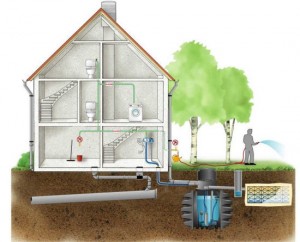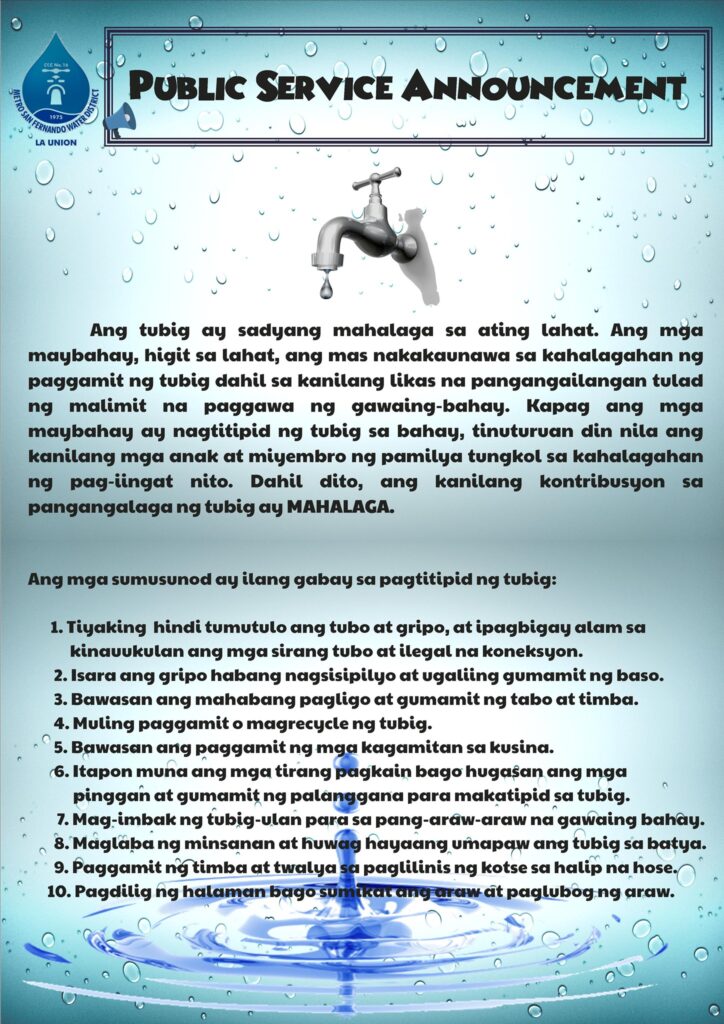Saving Water in the Office
We’re All In The Business of Saving Water
Water conservation is something few of us think about at work. Since we don’t get the bill there, we’re not aware of the cost and quantity of our consumption. But our offices and factories consume huge quantities of water, so saving on the job should be everyone’s business.
- Post a hotline in bathrooms and kitchens to report leaks or water waste to facility managers or maintenance personnel.
- Create a suggestion and incentives system at your organization to recognize water-saving ideas.
- Include a water-saving tip in your employee newsletter featuring how much water can be saved with each action.
- Implement a water management plan for your facility, then educate employees on good water habits through newsletters and posters.
- Publish your organization’s monthly water use to show progress toward water-saving goals.
- Invite your water utility conservation staff to your organization for Earth Day and other environmental events to help promote water savings.
- Have a water audit done for your facility to find out the recommended water use for your operations, then make sure someone monitors your utility bills to gauge your monthly consumption.
- Have maintenance personnel regularly check your facilities for leaks, drips and other water waste.
- If you use processed water in your business or facility, look into water recycling and reuse.
- Contact your water utility to see if rebates are available for purchasing water-efficient fixtures, equipment or for facility audits.
- Consider and compare water use when purchasing things like ice makers, dishwashers, reverse osmosis units, coolers and cleaning equipment.
- Appoint or volunteer to be a water conservation champion within your organization and create, implement and maintain your water conservation program.
- Determine how your on-site water is being used by installing sub-meters where feasible, then monitoring for savings.
- Conduct a facility water use inventory for domestic plumbing (sinks, toilets, showers), heating and cooling (cooling towers, boiler blow-down), kitchen plumbing (dishwasher, ice machines), process water (cooling, rinsing, chemical dilution), water features (pools, spas, fountains) and landscape irrigation. Then identify water management goals.
- Don’t forget hidden water-use costs, such as energy for pumping water, water heating and cooling, chemical treatment, water damage and sewer expenses.
- Show your company’s dedication to water conservation by creating a written policy statement and by committing management, staff, time and other resources to the effort.
- Shut off water to unused areas of your facility to eliminate waste from leaks or unmonitored use.
- Create a goal of how much water your company can save and plan a celebration once that goal is met.
- Ask employees for suggestions on saving water and give a prize for the best ideas. Incentivize it!
- Write feature articles on your employee website that highlight water-saving ideas and successes.
- Saving water in your landscape adds up quickly, so send the person in charge of your landscape to an irrigation workshop.
- Track the weather and water use in the landscape. Water use should decrease during rainy periods and increase during hot, dry periods.
- Visit your local Water Conservation office’s website to get information on programs available to businesses.
- Ask your company to sponsor or volunteer at events that support water conservation and education.
- Scrape dishes rather then rinse them before washing.
- Use water-conserving icemakers.
- A recent study that focused on business sustainability and environmental responsibility showed that 99% of business managers surveyed ranked water conservation as a “top five” priority over the next decade.
- If your facility is cooled with cooling towers, have maintenance staff or facility managers maximize cycles of concentration by providing efficient water treatment.
- Be sure your irrigation system is watering only the areas intended, with no water running onto walks, streets or down the gutter.
- Using a hose and nozzle to clean sidewalks uses 8 to 12 gallons of water per minute. With a pressurized Waterbroom®, you will clean more efficiently and use as little as 2.8 gallons of water per minute
- Make sure landscape irrigation systems are operating properly by inspecting regularly for leaks or broken sprinkler heads and adjusting pressures to the equipment specifications.
- Make sure your landscape is getting the proper amount of irrigation water. Determine water needs, water deeply but infrequently and adjust your controller to the season.
- Establish a monthly water budget for your landscape based on the water needs of your plants. Learn more from a WaterSense® certified irrigation auditor, your utility water conservation office, or from your local cooperative extension office.
- Place decorative fountains on a timer and use only during work or daylight hours. Periodically check for leaks if you have automatic refilling devices.
- Wash company vehicles at commercial car washers that recycle water.
- Wash company vehicles as needed rather than on a schedule. Stretch out the time in between washes.
- Consider turning your high-maintenance water feature/fountain into a low-maintenance art feature or planter.
- When buying new appliances, consider those that offer cycle and load size adjustments. They are more water and energy efficient.
- Upgrade older toilets with water-efficient models.
- Make sure there are water-saving aerators on all of your faucets.
- Install an instant water heater near your kitchen sink so you don’t have to run the water while it heats up. This also reduces energy costs.
- Support projects that use reclaimed wastewater for irrigation and industrial uses.
- When you have ice left in your cup from a take-out restaurant, don’t throw it in the trash. Pour it on a plant.
Home Tips
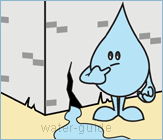 |
Check for home for leaks, hidden water leaks can be wasting water without you even being aware of it. A good way to check for leaks is, if your property is metered, then read your water meter and do not use any water for a couple of hours and go back to check that the meter reads exactly the same. If it does not, there is a leak. |
|
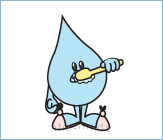 |
Turn off tap while cleaning your teeth, shaving or washing your face. You can waste up to 9 litres a minute by just letting the water pour down the sink. |
|
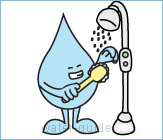 |
Take a short shower rather than a bath could save you up to 400 litres a week. If you do have baths, just half fill them. |
|
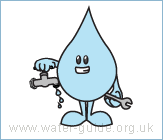 |
Fix any dripping tap, you can waste 90 litres a week which will cost a lot more than what might just be the price of a new washer. |
|
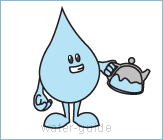 |
Don’t overfill the kettle when making a cup of tea. Only fill and boil what you need, this will save you money on your energy costs too. |
|
 |
Only use the washing machine and the dishwasher when you can put on a full load. It wastes both water and energy to run only a half full machine. |
|
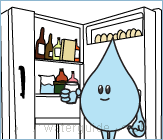 |
Keep cool water in the fridge so that you do not need to run water down the sink to have a cold drink. Fit water saving device in your cistern to save when flushing, this can save you 3 litres a flush. Think before throwing used water down the drain, eg water in a pan after cooking, this could be reused |
Garden Tips
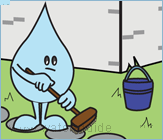 |
Use a broom and bucket of water for washing down the patio rather than a steady flow of water from the hose. |
|
 |
Install a water butt in the garden to collect the rain water. This will mean you always have water to use for watering the garden without the need to use fresh water from the hose. |
|
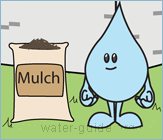 |
Using mulch on the garden with help the soil retains water so will mean you won’t have to water the garden as often. |
|
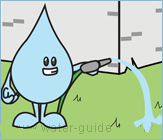 |
Don’t overuse hoses or sprinklers in hot weather. A sprinkler can use as much water in an hour as a family of four will use in a day. Your lawn only really needs watering once a week and it is better to water in the morning when the temperature is lower and evaporation is less. Research your plants, some actually thrive in drier conditions and will not benefit from over |
|
|
|
||
|
Use a sponge and bucket of water to clean your car or if you use the hose, ensure you use a shut off nozzle so the water is not constantly running. |
||

 As creating and maintaining a healthy environment has become a high priority for many people, finding ways of recycling water and other important resources is very important. Along with this environmental concern, however, our government is also facing serious financial issues. Most people just do not have the funds available to install expensive ways of recycling water in their homes, even with the government incentives that are offered to those who purchase these systems.
As creating and maintaining a healthy environment has become a high priority for many people, finding ways of recycling water and other important resources is very important. Along with this environmental concern, however, our government is also facing serious financial issues. Most people just do not have the funds available to install expensive ways of recycling water in their homes, even with the government incentives that are offered to those who purchase these systems.